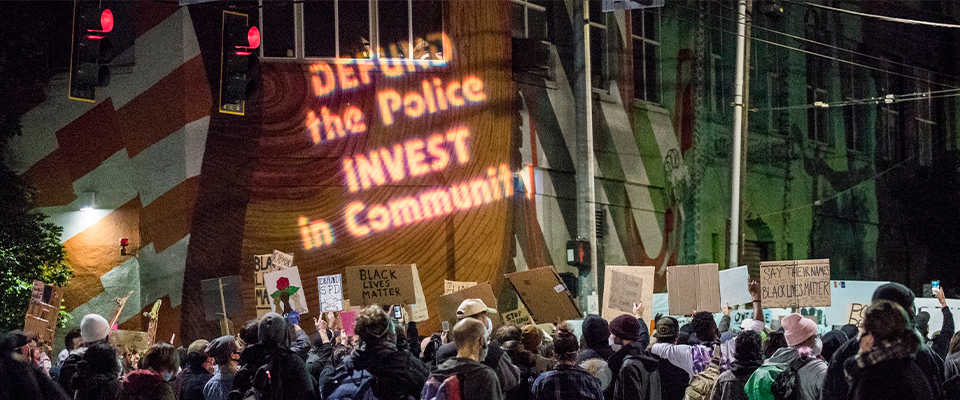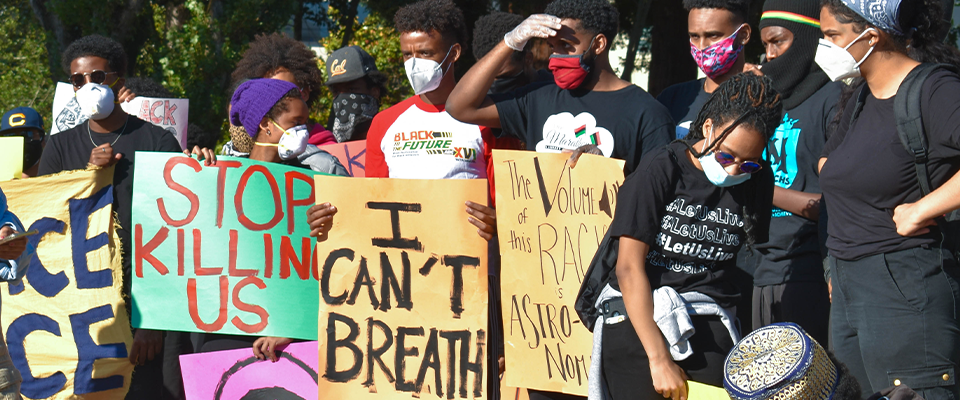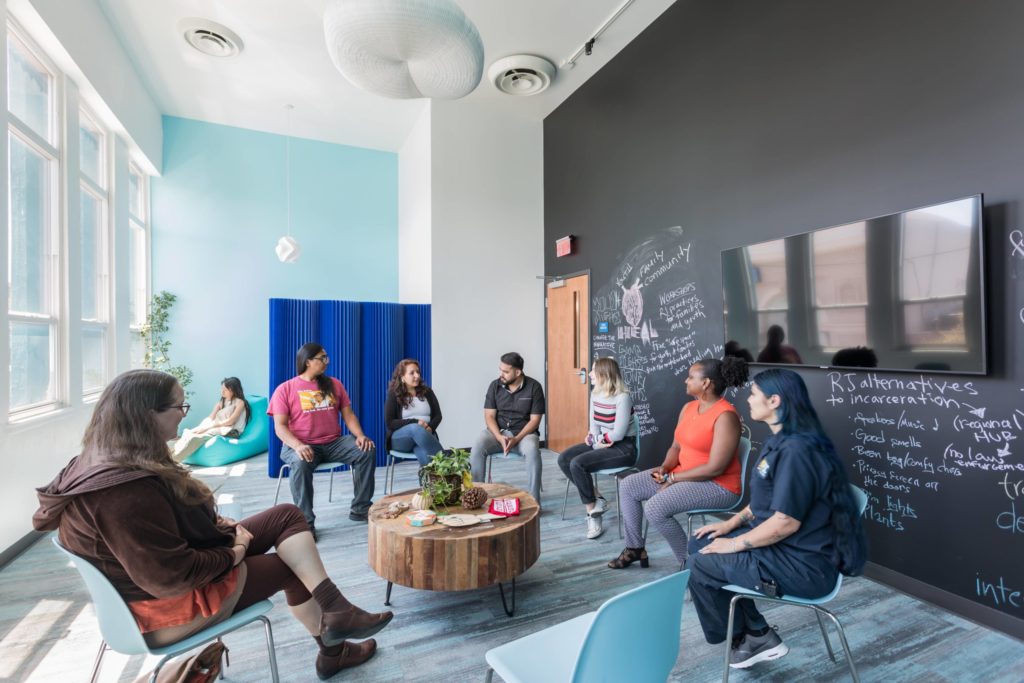As protests have swept the nation in response to the police killing of George Floyd in Minneapolis, the call to defund and abolish the police has also swept social media and marched its way into the national dialogue. The conversation—centered around reducing the number of police and shifting resources to investments in education, housing, mental health care, and other community investments that address social problems without the involvement of law enforcement—represents a marked shift from the call for more body cameras, better training, and other reforms that dominated the national dialogue after the police killing of Michael Brown in Ferguson in 2014.
Officials in multiple cities, including Los Angeles, New York City, and San Francisco, have announced that they intend to reduce the police department budget and reinvestment those resources in Black communities. In Minneapolis, members of the City Council announced last week they intended to entirely disband the police department. California contributor Brandon Patterson talked to Nikki Jones, a UC Berkeley professor of African American Studies whose research focuses on policing and incarceration in Black communities, about how the conversation around addressing police abuse has evolved, what defunding the police and reinvesting resources could look like, and why she thinks now—during the COVID-19 pandemic—is the time to do it.
After Ferguson, police reform was identified as the fix for police violence. There have always been abolitionists within the Black Lives Matter movement, but in the wake of George Floyd’s murder, the idea of abolishing or at least seriously divesting from the police seems to be drawing more serious consideration. Why do you think that is?
Nikki Jones: During the rise of broken windows policing, there were scholars who said we should be investing in non-police resources. People have long critiqued the erosion of the social safety net and the shift of those resources to police. But those ideas have coalesced over the past five years in a way that people identify as abolitionist. There has also been a lot of work led by Critical Resistance [the prison abolitionist group founded at UC Berkeley in 1998] that has been picked up by police abolitionists.

My personal evolution [on this issue] has been through my research. Ten years ago I would have been one of the folks who was pushing for progressive reform in the criminal justice system and policing. But I’ve come to understand the limits of reform. It doesn’t mean that reform’s not important, because there are checks and accountability that need to be in place because they may help someone on the street who comes into contact with the police regularly. But I have come to understand that there are always going to be limits to any kind of reform within a law enforcement paradigm because of the structure of the paradigm.
Why does reform not go far enough?
NJ: Paul Butler makes a point in an article about the limits of criminal justice reform where he writes that police have superpowers: to stop, search, arrest, incarcerate, and kill. A lot of what we identify as a problem with policing is not something that would be addressed by reform. Law enforcement reform always exists in a law enforcement paradigm. When we think about divesting and investing, what we’re thinking about is eliminating the conditions under which people call on the police to manage [problems]. One of the ways to eliminate killings by the police is to have the police not interact with people—certainly not as frequently as they do right now. So divesting and investing acknowledges the need to shift our priorities: to shift funding and support from an institution that puts lives in jeopardy to institutions that are organized around well-being. Certainly there can be limits as well in those institutions. But what distinguishes the police from any other social institution is that the police are sanctioned to use violence by the state, and that violence is always central to any encounter. So we have to ask ourselves: Why are we using this institution to respond to the problem of homelessness? Why are we asking this institution to ensure discipline and control in schools? Why are we asking this institution to respond to people who are having mental health crises? Divestment and abolition begin with questioning the police’s monopoly on violence and asking questions about the institution’s relationship to the public.
What does the research show about the impact that policing and incarceration have on crime rates?
NJ: I try to not even talk about crime because we are at historic lows when it comes to crime. It’s been mostly on a downward trend over the last 20-plus years. Mass incarceration explains very little of that drop. But we also know that policing is bad for young people. Experiencing contact with the police is not good for young people. Witnessing aggressive encounters is not good for young people. Aggressive policing has a negative impact on the mental and physical health of people in the neighborhood—even those who aren’t the target of the encounter. It has an impact on schooling. There are a number of ways to stomp out crime, but if they’re doing this degree of harm to young people, should that be the approach we take anyway? We should be thinking less about a public safety approach and more about what it looks like to build the capacity of young people. What does it mean to have a healthy neighborhood and healthy communities? What institutions do we invest in for our young people?
So what are those institutions?
NJ: If we think about K-12 schools and what’s happening in school districts across the country, they are saying, “We don’t want police in schools.” The second step is to invest in resources to serve students in these schools. That means many more counselors. That means providing family support. You can extend resources that are available in schools to improve the conditions of families as well. That means a whole host of resources and extracurriculars that are oriented around building the capacity of students. It really means an investment.
Writer Josie Duffy Rice of The Appeal noted on Twitter recently that many white people live in communities where there is safety and security without rampant police violence and mass incarceration because they have access to good jobs, housing, and other resources.
NJ: What they also have is that they’re white. And in those neighborhoods, police aren’t as physically present in their lives. But the police also serve them differently. They understand that they can always rely on the police if they need to and that the police are doing the work of keeping people who shouldn’t be in their neighborhood out. It is a fundamentally different way of having the police in your neighborhood.
Some people worry that divestment from and abolition of policing would result in increased violence and public safety concerns. How would you respond to that?
NJ: People will say, “There are people who do real harm. What do we do with them?” That’s a question to be asked—but it’s a question that deserves a serious line of inquiry. You have seen Black feminist activists think seriously about this question. Aishah Simmons, for example, has done a lot of work around what you do in cases of incest in Black families and how you address that harm outside of the criminal justice system. What’s great about this moment is that we have people not just using that question as a barrier to progress, but really thinking through, ‘What does it mean for someone to be separated from society for a time?’ People can be separated from society and not be systematically degraded and dehumanized in harsh conditions. There are other ways to separate if necessary and address whatever the issue is. But we have many more people in our system than actually need that kind of intervention. There are people on the ground who are already figuring out what we do instead—for example, the restorative justice movement. So that question is actually a beginning. It’s not a reason not to engage with the kinds of questions that abolitionists are asking us to engage in this moment. It’s an opportunity to open up our imagination. What we have now is a complete failure of imagination when it comes to addressing these issues.
Cities around the country are reducing their police budgets. The Minneapolis City Council plans to completely disband the city’s police department. Public officials are talking about the need to “reimagine public safety” which was unheard of on this scale a month ago.
NJ: That is groundbreaking. Institutions have not been taking responsibility for thinking about what community safety means. Now, they will have to have the kinds of conversations that they hadn’t had the space to have previously. I hope it cascades across the country.
The moment belongs to abolition. What I would say to other people is to be open to this moment and the possibilities that can emerge if people are not afraid and fearful of the words “defund” and “abolition.” Leaders are also saying, ‘We want the police out of schools.’ People are saying, ‘We’re going to challenge union contracts.’ What this moment requires is for people to realign themselves. Many people are de-facto aligned with law enforcement. They believe the police to be protectors—and, in fact, they may protect them. But if you align yourself with the people who are the most frequent targets of policing and then ask yourself the question, ‘What kind of world would emerge from this perspective where this person’s well-being is at the center?’ then the role of police diminishes because the police don’t provide that.
Some major cities spend half of their budgets on the police. What has to happen to change that?
NJ: The challenge is disrupting this presumption that the way policing is structured in cities is the way it needs to be because it’s the way it has always been and there is no other way for it to be. We should also ask the question: Should we be spending more on law enforcement than education? Let’s make that budget transparent and then ask, should that be our priority as a city or a state?
Some have argued that now—during the COVID-19 pandemic when state and local governments are strapped for cash and looking at rebuilding their economies—is the perfect time to make these major changes in resource allocation. What do you think?
NJ: That’s absolutely right. Where do we need the money? You can’t have both things. There are neighborhoods that are most impacted by COVID-19 and need the most resources when it comes to health and economics. What’s going to help those communities the most: more policing or better health care and economic stability? It’s the last two. We have to shift our budget in a way that reflects what ought to be our priorities.
Final thoughts?
NJ: The system does not need our help. Law enforcement does not need our protection. People do. Law enforcement is a distributor of violence in the lives of young people and Black people. So whose side are you going to stand on? We’re in a moment where more people can ask themselves that question and readjust where they position themselves. Once you do that, the sort of actions that you take flow from that.





















